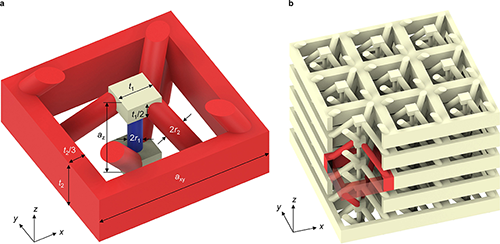| Jun 10, 2021 |
Novel materials: Sound waves traveling backwards
(Nanowerk News) Acoustic waves in gases, liquids, and solids usually travel at an almost constant speed of sound. So-called rotons are an exception: their speed of sound changes significantly with the wavelength, and it is also possible that the waves travel backwards.
|
|
Researchers at Karlsruhe Institute of Technology (KIT) are studying the possibilities of using rotons in artificial materials. These computer-designed metamaterials, produced by ultra-precise 3D laser printing, might be used in the future to manipulate or direct sound in ways that have never been possible before.
|
|
A report on the researchers’ work has been published in Nature Communications ("Roton-like acoustical dispersion relations in 3D metamaterials").
|
 |
| Designed elastic metamaterial structure made of a single linear elastic material. (Image: Dr. Yi Chen, KIT) (click on image to enlarge)
|
|
Rotons are quasiparticles, which means that they behave similarly to free particles. Unlike ordinary acoustic waves in gases, liquids, and solids, the speed of sound changes significantly with the wavelength. In addition, certain frequencies generate three different partial waves.
|
|
“The slowest among them is a backward wave: the energy flow and the wavefronts run in exactly opposite directions,” explains Professor Martin Wegener from the Institute of Applied Physics (APH) and KIT’s Institute of Nanotechnology (INT). Understanding and benefiting from quasiparticles such as rotons is one of the great challenges of quantum physics.
|
|
Physicist Lev Landau, who won a Nobel Prize in 1962 for his groundbreaking work, predicted their existence in the context of superfluidity, a condition in which a fluid loses its internal friction and becomes thermally conductive in a nearly ideal way. Until now, rotons could only be observed under special quantum-physical conditions at very low temperatures – and were therefore not suitable to technical applications.
|
Rotons without Any Quantum Effects
|
|
This might change in the future: in the 3D Matter Made to Order Cluster of Excellence of KIT and the University of Heidelberg, a group of researchers is working on metamaterials that “grow” rotons.
|
|
Metamaterials exhibit optical, acoustic, electrical, or magnetic properties that are not found in nature. The scientists propose an artificial material that can produce rotons without any quantum effects under normal ambient conditions and at almost random frequencies or wavelengths. Thus, it might be possible in the future to better manipulate sound waves in air or in materials, for example, to bounce them back, redirect them, or create echoes.
|
|
These materials have not been demonstrated experimentally yet; however, it should be possible to produce them by using technologies such as ultra-precise 3D laser printing. “We have even made some of these metamaterials in the meantime,” Professor Martin Wegener says. “Currently, we are working intensively on the direct experimental proof for the existence of rotons.”
|
3D printing – the Gateway from the Digital to the Physical World
|
|
Dr. Yi Chen, lead author of the publication, explains that the researchers relied on a combination of reflection, many discussions and numerical simulations and optimizations to devise the computer-aided virtual design of materials with such novel properties. His work as a post-doctoral researcher at KIT is funded by the Alexander von Humboldt Foundation and is integrated into a Helmholtz program entitled “Material Systems Engineering” launched in 2021.
|
|
“In general, our dream is to design materials on the computer and then turn them directly into reality – without years of trial and error. So 3D printing is just an automated converter, as it were, from the digital to the physical world,” Professor Martin Wegener explains.
|

